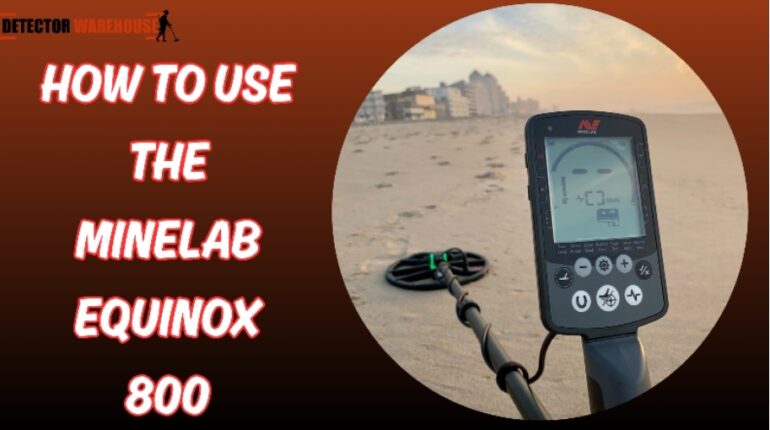If you’ve just picked up a Minelab Equinox 800 or are thinking about getting one, you’re in for a treat. The Equinox 800 is one of the most versatile minelab metal detector models out there, designed for everything from coins and relics to gold and saltwater beach hunting. But like any advanced machine, the buttons, settings, and tones can feel overwhelming at first. Don’t worry—this guide breaks down exactly how to use the Minelab Equinox 800 in simple steps, with tips you can put into practice on your very first hunt.
Getting Started with the Minelab Equinox 800
Out of the box, you’ll find the control box, shaft, coil, and wireless headphones. Before you hit the field, charge the lithium battery fully using the magnetic USB charging cable. A single charge lasts up to 12 hours, but if you’re planning a long day at the beach or in the woods, it’s always smart to bring a power bank.
To power up, hold down the power button until the screen lights up. The Equinox will automatically load into the last search mode you used. For beginners, starting in Park 1 is a safe choice since it’s designed for coin and jewelry hunting in modern areas like parks and yards.
Understanding the Controls and Display
One of the biggest learning curves with the Equinox 800 is its Target ID system. Every target you swing over will display a number on the screen ranging from -9 to 40:
- Negative numbers (−9 to −1) usually mean iron or junk.
- Low to mid numbers (1–19) can be foil, pull tabs, small gold, or nickels.
- High numbers (20–40) typically indicate copper, silver coins, or other valuable metals.
The tones are just as important. For example, a U.S. quarter usually gives a clear, repeatable signal around 29–32. Once you learn how these numbers sound, you’ll start digging less trash and more treasure.
Choosing the Right Search Mode
The Equinox 800 comes with multiple search modes, each optimized for a different environment:
- Park Mode – Perfect for coins and jewelry in modern, trash-filled areas.
- Field Mode – Best for relics and older targets in farm fields.
- Beach Mode – Handles both dry and wet sand, plus shallow saltwater without excessive chatter.
- Gold Mode – Designed for prospectors hunting small nuggets in highly mineralized soil.
As a beginner, stick to Park or Field until you’re comfortable. If you’re at the beach, switch to Beach 1 for dry sand or Beach 2 for wet sand and surf.
Ground Balance and Noise Cancel
To get stable performance, you’ll need to ground balance your detector. Simply hold the coil a few inches above clean ground, press the ground balance button, and pump the coil up and down. This helps cancel out the mineralization in the soil.
Next, use the Noise Cancel feature. Hold the button while keeping your coil still, and the detector will automatically find the quietest frequency channel. This is especially useful if you’re near power lines or hunting in a noisy urban area.
Adjusting Sensitivity and Recovery Speed
Sensitivity controls how deep and how small of a target you can detect. Start at around 20–22 sensitivity. If your detector becomes too chatty with false signals, lower it a few notches.
Recovery speed is another powerful feature. A higher recovery speed (like 6 or 7) helps separate targets in trashy areas but reduces depth. A lower speed (3 or 4) gives you maximum depth but can make close targets blend together. For example, if you’re coin shooting in a park filled with pull tabs, go higher. If you’re relic hunting in a clean field, go lower for depth.
Sweep Technique: How to Detect Properly
One of the most common beginner mistakes is swinging the coil too fast or too high off the ground. Keep the coil 1–2 inches above the surface, level to the ground, and overlap each swing by about 50%. Move slowly and listen for repeatable signals. If a target only beeps once, it’s probably trash—but if it repeats from multiple angles, dig it.
Pinpointing and Digging Targets
Once you get a solid signal, press the Pinpoint button (bullseye icon). Move the coil slowly over the target until the sound peaks—that’s the sweet spot to dig. A simple hand digger works fine for parks, but for beaches or fields, a sand scoop or small shovel will save you time. Always dig a neat plug so you can leave the area looking as if you were never there.
Tips for Different Environments
- Parks: Use Park 1, keep recovery speed high, and watch for coins around playgrounds and picnic tables.
- Beaches: Switch to Beach 2 for wet sand and surf. Lower sensitivity if waves make the detector unstable.
- Fields: Relics often sit deep. Use Field 2 with a lower recovery speed for maximum depth.
- Gold hunting: In Gold Mode, sensitivity and threshold tone are critical. Practice on small test nuggets first.
Maintenance and Care
After a hunt, especially in saltwater, rinse the coil and shaft with fresh water. The Equinox 800 is waterproof up to 10 feet, but never leaves saltwater to dry on the machine—it can corrode metal parts over time. Store the detector in a cool, dry place and recharge the battery every few weeks, even if unused.
Conclusion
The Minelab Equinox 800 is one of the most beginner-friendly yet powerful detectors you can own. By learning the basics—like reading target IDs, adjusting sensitivity, and choosing the right mode—you’ll quickly build confidence in the field. The key is practice: bury a few coins in your backyard and train your ears to the sounds of different metals. Before long, you’ll be digging up more treasure and less junk.
So, grab your Equinox 800, get out there, and start hunting—you never know what history is waiting just below your feet.






